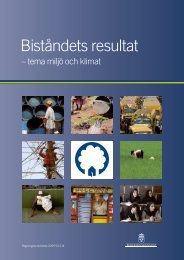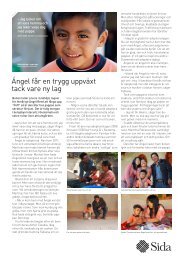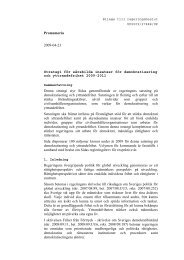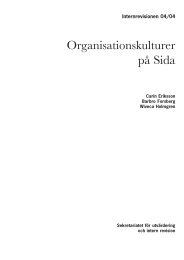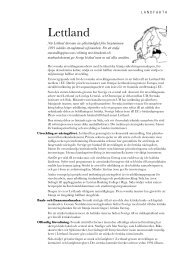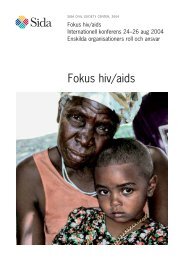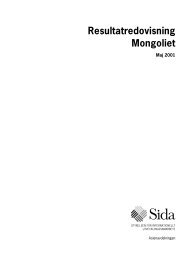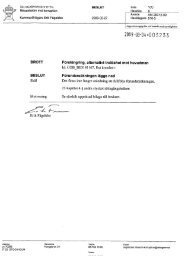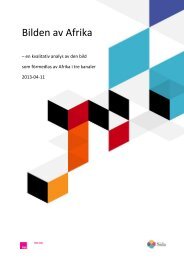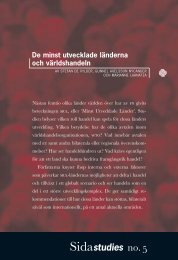Mid-Term Review of the AGIR Programme - Sida
Mid-Term Review of the AGIR Programme - Sida
Mid-Term Review of the AGIR Programme - Sida
Create successful ePaper yourself
Turn your PDF publications into a flip-book with our unique Google optimized e-Paper software.
1 I N T R O D U C T I O N<br />
Based on this perspective, <strong>the</strong> selected organisations in Nampula cover three subprogrammes:<br />
Electoral Observatory, Juvenile Parliament (political accountability);<br />
Rede da Criança (Children´s Rights Network); Association <strong>of</strong> <strong>the</strong> Blind and Partial<br />
Sighted <strong>of</strong> Mozambique based in Beira (vulnerable people’s rights – blind people),<br />
Diakonia; Forum <strong>of</strong> Community Radios, (access to information /IBIS); Mozambican<br />
Debt Group and Forum Mulher representatives and Akilizetho (Nampula-based organisation<br />
focusing district decentralisation), Oxfam; and a member <strong>of</strong> <strong>the</strong> Lareira<br />
Crítica (External Advisory and Partner Support Group to SCC) – Luisa H<strong>of</strong>fman<br />
(SCC). The sample is particularly skewed to <strong>the</strong> Diakonia sub-programme due to <strong>the</strong><br />
fact that it had more representative organisations in Nampula. In light <strong>of</strong> this, <strong>the</strong> review<br />
team took <strong>the</strong> opportunity to interview as many organisations as possible at <strong>the</strong><br />
local level in <strong>the</strong> effort to assess <strong>the</strong> effectiveness <strong>of</strong> this reach. Apart from ACAMO<br />
(Association <strong>of</strong> <strong>the</strong> Blindand Partial Sighted <strong>of</strong> Mozambique, based in Beira), which<br />
has its headquarters in S<strong>of</strong>ala, each organisation’s senior management was interviewed<br />
at <strong>the</strong> central level. FORCOM (Forum <strong>of</strong> Community Radios) was contacted<br />
and was sent a list <strong>of</strong> questions which were responded to in writing. One government<br />
represenative was also interviewed as was a member <strong>of</strong> “Lareira Critica”, an external<br />
monitoring mechanism <strong>of</strong> <strong>the</strong> SCC sub-programme.<br />
The selection <strong>of</strong> Tete province was chosen as an example <strong>of</strong> challenges faced by <strong>the</strong><br />
<strong>AGIR</strong> programme in central Mozambique. With a noticeably weak civil society (in<br />
<strong>the</strong> Mozambican context), Tete province is faced with acute challenges in engagement,<br />
advocacy, and human rights issues (resettlement and conflict at <strong>the</strong> local level<br />
in connection with <strong>the</strong> expanding mining industry) linked to areas <strong>of</strong> governance<br />
transparency and accountability at national and international levels.<br />
In contrast with Nampula, where various donors have been directly represented for a<br />
number <strong>of</strong> years, Danida is <strong>the</strong> only donor with a long-term engagement with Tete<br />
province dating back to <strong>the</strong> civil war. In Nampula, a number <strong>of</strong> strong innovative international<br />
development Non-Governmental Organisations (NGOs) (incl. SNV (International<br />
Non-Governmental Organisation, Dutch), CONCERN (International Non-<br />
Governmental Organisation, Irish), CLUSA (International Non-Governmental Organisation,<br />
American), CARE (International Non-Governmental Organisation, American))<br />
have, since <strong>the</strong> 1990s, provided systematic and focused capacity development<br />
for local NGOs in specialised fields such as decentralisation and governance, extension<br />
services, saving groups and farmers associations, and modern cooperative<br />
movements.<br />
In Tete <strong>the</strong> INGO landscape has been focused on humanitarian response (MSF (International<br />
Non-Governmental Organisation, Doctors without Borders)), agriculture<br />
(World Vision), and only recently has been complemented by a range <strong>of</strong> HIV/AIDS<br />
oriented organisations. Overall, <strong>the</strong> <strong>the</strong>matic scope <strong>of</strong> INGOs and local NGOs in Tete<br />
is much more limited than in Nampula, with local CSOs not yet benefiting from <strong>the</strong><br />
kind <strong>of</strong> solid, continuous, focused capacity development and specialisation <strong>of</strong>fered by<br />
INGOs as in Nampula or from national/central CSOs. There are a number <strong>of</strong> reasons<br />
contributing to <strong>the</strong>se differences. First is <strong>the</strong> fact that Tete was heavily impacted by<br />
<strong>the</strong> war and attracted a number <strong>of</strong> humanitarian organisations during <strong>the</strong> war and its<br />
28




